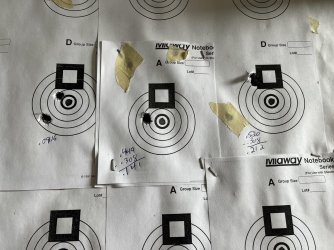Mikecr
Well-Known Member
There is no scenario where softer brass provides higher tension.
Harder brass ALWAYS provides higher tension potential.
As far as I'm aware, this holds with ANY metal or material otherwise.
A misunderstanding that resides in this community like a virus, is a notion that interference fit and/or friction directly correlate with hoop tension.
That is false. They are each separate and different.
What grips bullets is spring back force per area applied. And this would be expressed in PSI,, not inches, not friction coefficient, and not the cost of your annealing machine.
Don't let merchandising fool you. Test each for yourself.
Increase friction of a neck, shoot it across a chrono, observe no change in MV
Change interference for a sized length no more than seated bearing, see very little to no change in MV.
Now adjust that sizing length, to alter actual tension (with area applied), and see MV follow directly.
If you establish the same interference, for the same sized length, work hardened brass will produce higher MV than fully annealed brass.
It's bullet grip is higher.
This is because the broken grain structure of work hardened brass resists dimension changes, whereas the grain structure of fully annealed brass allows dimension changes with less tension applied.
Harder brass ALWAYS provides higher tension potential.
As far as I'm aware, this holds with ANY metal or material otherwise.
A misunderstanding that resides in this community like a virus, is a notion that interference fit and/or friction directly correlate with hoop tension.
That is false. They are each separate and different.
What grips bullets is spring back force per area applied. And this would be expressed in PSI,, not inches, not friction coefficient, and not the cost of your annealing machine.
Don't let merchandising fool you. Test each for yourself.
Increase friction of a neck, shoot it across a chrono, observe no change in MV
Change interference for a sized length no more than seated bearing, see very little to no change in MV.
Now adjust that sizing length, to alter actual tension (with area applied), and see MV follow directly.
If you establish the same interference, for the same sized length, work hardened brass will produce higher MV than fully annealed brass.
It's bullet grip is higher.
This is because the broken grain structure of work hardened brass resists dimension changes, whereas the grain structure of fully annealed brass allows dimension changes with less tension applied.

